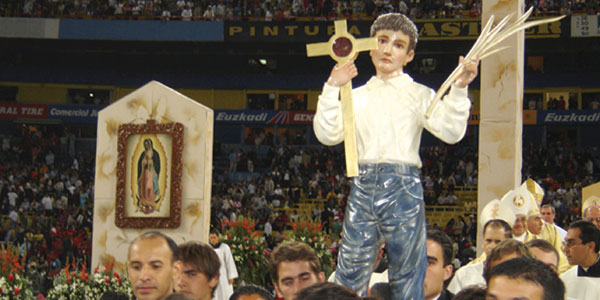
(Del sitio web del Vaticano vatican.va) José Sánchez del Río nació el 28 de marzo de 1913 en Sahuayo, Michoacán, México. Al desear defender su fe y derecho de los católicos, él siguió los pasos de sus dos hermanos mayores y le pidió a su madre permiso para unirse a los Cristeros. Ella se opuso, diciéndole que estaba demasiado joven. Él respondió: “Mamá, no me dejes perder la oportunidad para ganarme el cielo tan fácilmente y tan pronto”.
El 5 de febrero de 1928 el joven fue capturado durante una batalla y arrestado en la sacristía de la Iglesia. Con el fin de aterrorizarlo, los soldados lo forzaron que presenciara la muerte en la horca de otro Cristero capturado. Pero José motivó al hombre diciendo, “Usted llegará al cielo antes que yo. Prepare un lugar para mí. Dígale a Cristo Rey que pronto estaré con Él».
En la prisión, el rezaba el Rosario y cantaba canciones religiosas. Él escribió una hermosa carta para su madre diciéndole que estaba resignado a cumplir con la voluntad de Dios. El padre de José intentó pagar rescate por su hijo, pero no pudo recaudar el dinero a tiempo.
El 10 de febrero de 1928 el adolescente fue brutalmente torturado, le quitaron la piel de la planta de sus pies, y luego lo forzaron a caminar sobre sal, seguido de hacerlo caminar por el pueblo hacia el cementerio. El joven gritaba con dolor pero no se rindió.
En momentos los soldados lo detenían y le decían, “Si gritas, «Muerte a Cristo Rey», te perdonamos la vida». Pero él contestaba: «¡Que viva Cristo Rey, que viva Nuestra Señora de Guadalupe!».
Una vez que llegó al cementerio, a José se le pidió una vez más que negara su religión. El joven de 14 años gritó: «¡Viva Cristo Rey!», y le dispararon brusca y repentinamente.
Mexico’s new Saint
By Nicholas Peterson
(From the Vatican website vatican.va) José Sánchez del Río was born on 28 March 1913 in Sahuayo, Michoacán, Mexico. Wanting to defend the faith and rights of Catholics, he followed in the footsteps of his two older brothers and asked his mother for permission to join the Cristeros. She objected, telling him that he was too young. “Mama”, he replied, “do not let me lose the opportunity to gain Heaven so easily and so soon”.
On 5 February 1928 the young boy was captured during a battle and imprisoned in the church sacristy. In order to terrorize him, soldiers made him watch the hanging of one of the other captured Cristeros. But José encouraged the man, saying, “You will be in Heaven before me. Prepare a place for me. Tell Christ the King I shall be with him soon”.
In prison, he prayed the Rosary and sang songs of faith. He wrote a beautiful letter to his mother telling her that he was resigned to do God’s will. José’s father attempted to ransom his son, but was unable to raise the money in time.
On 10 February 1928 the teenager was brutally tortured and the skin of the soles of his feet was sheered off; he was then forced to walk on salt, followed by walking through the town to the cemetery. The young boy screamed with pain but would not give in.
At times the soldiers stopped him and said, “If you shout, “Death to Christ the King’, we will spare your life”. But he answered: “Long live Christ the King! Long live Our Lady of Guadalupe!”.
Once he arrived at the cemetery, José was asked once more if he would deny his faith. The 14 year old shouted out: “Long live Christ the King!”, and was summarily shot.









